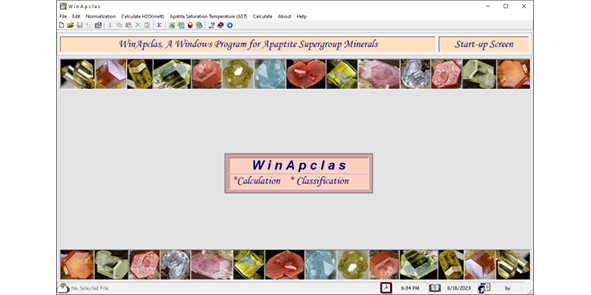WinApclas, A Windows program for apatite supergroup minerals
DOI:
https://doi.org/10.13133/2239-1002/18203Abstract
A Microsoft® Visual Basic software, called WinApclas, has been developed to calculate and classify wet chemical and electron-microprobe apatite supergroup mineral analyses based on the New Minerals, Nomenclature and Classification (CNMMN) of the International Mineralogical Association (IMA-10) nomenclature scheme. The program evaluates the 47 approved species based on the dominant cations at the M and T sites and anions at the X site in the reduced general formula IXM12VIIM23(IVTO4)3X within the apatite, hedyphane, belovite, britholite and ellestadite groups. Mineral analyses of the apatite supergroup species are calculated with different estimation and normalization options including 13 total anions, 8 total (M+T=8), 3T (P+As+V+Si+S=3), 8 total (M=5 and T=3) and 5M cations, respectively. Using the calculated anion values of apatite supergroup mineral analyses, the program first allocates the T site cations with charges between +4 and +6 and then shares all remaining cations with smaller ones in the range of +1 to +3 to fill the M site. Considering the dominant M and T site anions, WinApclas determines the apatite supergroups and defines the species in each group according to the dominant valance and constituents on the basis of dominant X anion such as F-, Cl- and OH-. The program allows the users to enter total 79 input variables that 54 of them (wt%) are used for the calculation and classification of apatite supergroups minerals, two of them (wt%) belonging to the melt or whole-rock SiO2 and P2O5 compositions to be used in estimation of the apatite saturation temperature values (oC) and the rest 23 for apatite trace (ppm) and rare earth element (REE) contents to handle the compositional and discrimination plots for provenance and mineral exploration studies. By applying the semi-quantitative formulae for apatite mineral analyses, WinApclas also provides the user to estimate the F, Cl and relative S contents (ppm) of melts as well as the redox states of magmas. All the calculated values are stored in an output Microsoft® Excel file that can be used for further evaluations. WinApclas is distributed as a self-extracting setup file, including the necessary support files used by program, a help file, and representative sample data files.

Downloads
Additional Files
Published
Issue
Section
License
Copyright (c) 2023 Periodico di Mineralogia

This work is licensed under a Creative Commons Attribution 4.0 International License.

